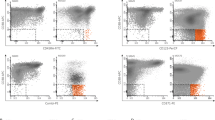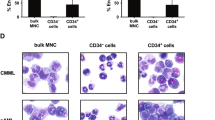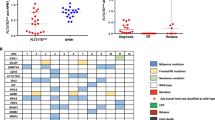Abstract
Apoptosis is the common cell death pathway which is initiated by a variety of different stimuli. The recognition of early apoptotic events would markedly improve reliability and convenience of apoptosis assays. In the present study the vital stain SytoR16 in combination with the permeability marker 7-amino actinomycin D, (7-AAD) has been used to identify an early stage of apoptosis, not detected with trypan blue or 7-AAD alone or with conventional apoptosis tests and not consistently and only partly detected by the early apoptosis marker annexin V. The method was established using solid tumour cell lines treated with TNF. Subsequently we applied it to determine apoptotic populations in CD34+ peripheral blood progenitor cells obtained from growth factor and/or chemotherapy mobilised patients and frozen/thawed according to standard stem cell transplantation protocols. In a cell line model as well as CD34+ progenitor cells, different subpopulations with decreased SytoR16 fluorescence (SytoR16int or SytoR16low, compared with the normal SytoR16high) appeared which are not, or only partly, apoptotic using conventional techniques including morphology or 7-AAD staining: eg percentages of SytoR16int/7-AAD− and SytoR16low/7-AAD− may amount to the majority of cells present in a particular CD34+ sample. Second, upon further incubation these subpopulations become late apoptotic/secondary necrotic much faster than the unmodified SytoR16high population, as determined with 7-AAD staining and morphology. Third, these cells have strongly or completely reduced clonogenic capacity for committed (CFU-GM) and early (LTC-IC, determined only for CD34+ cells) progenitors. This technique needs the inclusion of a blocker of P-glycoprotein, which is highly active in CD34+ progenitor cells. This prevents the interference of the detection of SytoR16low apoptotic cells by SytoR16lowcells resulting from P-glycoprotein activity. By comparison with other apoptosis markers we found that early apoptotic subpopulations were detected in the order SytoR16>annexin V>7-AAD. In conclusion, the combination of SytoR16 and 7-AAD detects apoptotic events earlier than conventional apoptosis techniques or annexin V. Compared to the presently available viability tests, it allows a much better estimation of the number of viable clonogenic CD34+ cells after freeze/thawing. Bone Marrow Transplantation (2001) 27, 487–498.
This is a preview of subscription content, access via your institution
Access options
Subscribe to this journal
Receive 12 print issues and online access
$259.00 per year
only $21.58 per issue
Buy this article
- Purchase on Springer Link
- Instant access to full article PDF
Prices may be subject to local taxes which are calculated during checkout







Similar content being viewed by others
References
Darzynkiewicz Z, Juan G, Li X et al. Cytometry in cell necrobiology: analysis of apoptosis and accidental cell death (necrosis) Cytometry 1997 27: 1–20
Ormerod MG . The study of apoptotic cells by flow cytometry Leukemia 1998 12: 1013–1025
Bedner E, Li X, Gorczyca W et al. Analysis of apoptosis by laser scanning cytometry Cytometry 1999 35: 181–195
Sgonc R, Gruber J . Apoptosis detection-an overview Exp Gerontol 1998 33: 525–533
Kerr JFR, Wyllie AH, Currie AR . Apoptosis: a basic biological phenomenon with wide-ranging implications in tissue kinetics Br J Cancer 1972 26: 239–257
Vermes I, Haanen C, Steffens-Nakken H, Reutelingsperger C . A novel assay for apoptosis. Flow cytometric detection of phosphatidylserine expression on early apoptotic cells using fluorescein labelled Annexin V J Immunol Meth 1995 184: 39–51
Koopman G, Reutelingsperger CPM, Kuijten GAM et al. Annexin V for flow cytometric detection of phosphatidylserine expression on B cells undergoing apoptosis Blood 1994 84: 1415–1420
Martin SJ, Reutelingsperger CPM, McGahon AJ et al. Early redistribution of plasma membrane phosphatidylserine is a general feature of apoptosis regardless of the initiating stimulus: inhibition by overexpression of bcl-2 and abl J Exp Med 1995 182: 1545–1556
Anthony RS, McKelvie ND, Cunningham AJ et al. Flowcytometry using annexin V can detect early apoptosis in peripheral blood stem cell harvests from patients with leukaemia and lymphoma Bone Marrow Transplant 1998 21: 441–446
Zhang G, Gurtu V, Kain SR, Yan G . Early detection of apoptosis using a fluorescent conjugate of annexin V Biotechniques 1997 23: 525–531
Van Engeland M, Nieland LJW, Ramaekers FCS et al. Annexin V-affinity assay: a review on an apoptosis detection system based on phosphatidylserine exposure Cytometry 1998 31: 1–9
Frey T . Correlated flow cytometric analysis of terminal events in apoptosis reveals the absence of some changes in some models Cytometry 1997 28: 253–263
Gatti R, Belletti S, Orlandini G et al. Comparison of annexin V and calcein-AM as early vital markers of apoptosis in adherent cells by confocal laser microscopy J Histochem Cytochem 1998 46: 895–900
King MA, Radicchi-Mastroianni MA, Wells JV . There is substantial nuclear and cellular disintegration before detectable phosphatidylserine exposure during the camptothecin-induced apoptosis of HL-60 cells Cytometry 2000 40: 10–18
Carbonari M, Cibati M, Cherchi M et al. Detection and characterization of apoptosis peripheral blood lymphocytes in human immunodefiency virus infection and cancer chemotherapy by a novel flow immunocytometric method Blood 1994 83: 1268–1277
Curnow SJ, Barad M, Brun-Roubereau N, Schmitt-Verhulst AM . Flow cytometric analysis of apoptotic and nonapoptotic T-cell receptor transgenic thymocytes following in vitro presentation of antigen Cytometry 1994 16: 41–48
Schmidt I, Uittenbogaart CH, Giorgi JV . Sensitive method for measuring apoptosis and cell surface phenotype in human thymocytes by flow cytometry Cytometry 1994 15: 12–20
Swat W, Ignatowicz L, Kisielow P . Detection of apoptosis of immature CD4+8+ thymocytes by flow cytometry J Immunol Meth 1991 137: 79–87
Schmid I, Krall WA, Uittenbogaart CH et al. Dead cell discrimination with 7-amino-actinomycin D in combination with dual color immunofluorescence in single laser flow cytometry Cytometry 1992 13: 204–208
Herault O, Colombat P, Domenech J et al. A rapid single-laser flow cytometric method for discrimination of early apoptotic cells in a heterogeneous cell population Br J Haematol 1999 104: 530–537
Nicoletti I, Migliorati G, Pagliacci MC et al. A rapid and simple method for measuring thymocyte apoptosis by propidium iodide staining and flow cytometry J Immunol Meth 1991 13: 271–279
De Boer F, Draeger AM, van der Wall E et al. Changes in L-selectin expression on CD34-positive cells upon cryopreservation of peripheral blood stem cell transplants Bone Marrow Transplant 1999 22: 1103–1110
Shpall EJ, Wheeler CA, Turner SA et al. A randomized phase 3 study of peripheral blood progenitor cell mobilization with stem cell factor and filgrastim in high-risk breast cancer patients Blood 1999 93: 2491–2501
Poot M, Gibson LL, Singer VL . Detection of apoptosis in live cells by MitoTracker Red CMXRos and SYTO dye flow cytometry Cytometry 1997 27: 358–364
Broxterman HJ, Schuurhuis GJ, Lankelma J et al. Highly sensitive and specific detection of P-glycoprotein function for haematological and solid tumour cells using a novel nucleic acid stain Br J Cancer 1997 76: 1029–1034
Schuurhuis GJ, Monnee-v, Muijen M, Bontje PM et al. Syto16 detects early apoptosis in several cell systems, including freeze–thawed CD34 positive progenitor/stem cells, earlier than annexin V Blood 1998 92: (Suppl. 1) 121a (Abstr. 488)
Schuurhuis GJ, Broxterman HJ, Ossenkoppele GJ et al. Functional multidrug resistance phenotype associated with combined overexpression of Pgp/MDR1 and MRP together with 1-b-D-arabinofuranosylcytosine sensitivity may predict clinical response in acute myeloid leukemia Clin Cancer Res 1995 1: 81–93
Sutherland HJ, Lansdorp PM, Henkelman DH et al. Functional characterization of individual human hematopoietic cells cultured at limiting dilution on supportive marrow stromal layers Proc Natl Acad Sci USA 1990 87: 3584–3588
De Boer F, Draeger AM, van Haperen MJAM et al. Differences in quality of CD34+ peripheral blood stem cells in whole blood transplants versus leucapheresis material Haematologica 1999 84: 256 (Abstr)
Frey T . Nucleic acid dyes for detection of apoptosis in live cells Cytometry 1995 21: 265–274
Neyfakh AA . Use of fluorescent dyes as molecular probes for the study of multidrug resistance Exp Cell Res 1988 174: 168–176
Henon Ph, Sovalat H, Becker M et al. Primordial role of CD34+38− in early and late trilineage haemopoietic engraftment after autologous blood cell transplantation Br J Haematol 1998 103: 568–581
Hirao A, Kawano Y, Takaue Y et al. Engraftment potential of peripheral and cord blood stem cells evaluated by a long-term culture system Exp Hematol 1994 22: 521–526
Keeney M, Chin-Yee I, Weir K et al. Single platform flow cytometric absolute CD34+ cell counts based on the ISHAGE guidelines. International Society of Hematotherapy and Graft Engineering Cytometry 1998 34: 61–70
Dercksen MW, Gerritsen WR, Rodenhuis S et al. Expression of adhesion molecules on CD34+ cells: L-selectin+ cells predict a rapid platelet recovery after peripheral blood stem cell transplantation Blood 1995 85: 3313–3319
Levesque JP, Simmons PJ . Cytoskeleton and integrin-mediated adhesion signalling in human CD34+ hemopoietic progenitor cells Exp Hematol 1999 27: 579–586
Peled A, Petit I, Kollet O et al. Dependence of human stem cell engraftment and repopulation of NOD/SCID mice on CXCR4 Science 1999 283: 845–848
Acknowledgements
The authors thank Petra Bontje for help with the morphological determination of apoptosis.
Author information
Authors and Affiliations
Rights and permissions
About this article
Cite this article
Schuurhuis, G., Muijen, Mv., Oberink, J. et al. Large populations of non-clonogenic early apoptotic CD34-positive cells are present in frozen-thawed peripheral blood stem cell transplants. Bone Marrow Transplant 27, 487–498 (2001). https://doi.org/10.1038/sj.bmt.1702809
Received:
Accepted:
Published:
Issue Date:
DOI: https://doi.org/10.1038/sj.bmt.1702809
Keywords
This article is cited by
-
Successful second autologous engraftment after long duration storage of hematopoietic stem cells
Bone Marrow Transplantation (2013)
-
Increased numbers of small circulating endothelial cells in renal cell cancer patients treated with sunitinib
Angiogenesis (2009)
-
The impact of post-thaw colony-forming units-granulocyte/macrophage on engraftment following unrelated cord blood transplantation in pediatric recipients
Bone Marrow Transplantation (2007)
-
Separation of apoptotic cells using a microfluidic device
Biotechnology Letters (2007)
-
Apoptotic lymphocytes and CD34+ cells in cryopreserved cord blood detected by the fluorescent vital dye SYTO 16 and correlation with loss of L-selectin (CD62L) expression
Bone Marrow Transplantation (2006)



